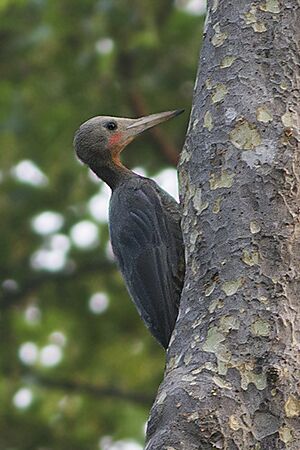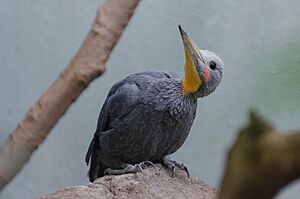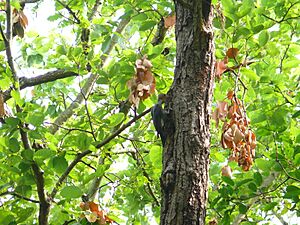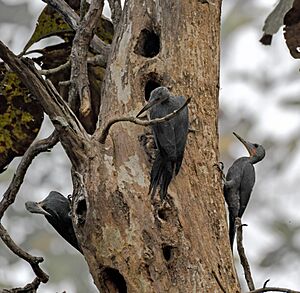Great slaty woodpecker facts for kids
Quick facts for kids Great slaty woodpecker |
|
|---|---|
 |
|
| A male Great Slaty Woodpecker from Kaladhungi, Uttarakhand, India | |
| Conservation status | |
| Scientific classification | |
| Genus: |
Mulleripicus
|
| Species: |
pulverulentus
|
 |
|
The great slaty woodpecker (Mulleripicus pulverulentus) is a very large bird. It belongs to the woodpecker family. You can find it across the Indian Subcontinent and Southeast Asia. This bird is easy to spot because of its unique look. It is also the biggest known species of woodpecker in the world.
Contents
Where Does It Live?
This amazing bird lives in many countries across Asia. You can find it in Bangladesh, Bhutan, Brunei, and Cambodia. It also lives in India, Indonesia, Laos, and Malaysia. Other places include Myanmar, Nepal, the Philippines, Singapore, Thailand, and Vietnam. It lives on the Greater Sunda islands, but not in Bali.
What Kind of Home Does It Like?
The great slaty woodpecker loves to live in old, thick forests. These are often moist deciduous or tropical evergreen forests. Sometimes, it might visit nearby younger forests or clearings. However, it usually avoids places that have been disturbed a lot by people.
It especially likes forests with large dipterocarp and teak trees. You can also find it in sal forests, swamp forests, and mangroves. These places must have tall, old trees. This woodpecker usually lives below 600 meters (about 2,000 feet) in height. But sometimes, it can be found higher up, even up to 2,000 meters (about 6,500 feet).
What Does It Look Like?
The great slaty woodpecker is the largest woodpecker in the world. It is about 48 to 58 centimeters (19 to 23 inches) long. It weighs between 360 and 563 grams (about 0.8 to 1.2 pounds).
This woodpecker has a unique look. It has a very long, strong bill that looks like a chisel. It also has a long neck and a long tail. Sometimes, you might see a small crest of feathers on its head. Its feathers are mostly dark grey or blackish. They have small white spots all over. The throat is a lighter grey. Male woodpeckers have a small red stripe near their beak, like a mustache.
For such a big bird, the great slaty woodpecker has a quiet voice. Other large woodpeckers often have very loud calls. Its call sounds like a soft, whinnying cackle. It usually has 2 to 5 notes, often 4, like "woikwoikwoikwoik." The first note is higher, and the middle one is lower. Sometimes, it makes single "dwot" calls when it's sitting or flying. Breeding pairs might even softly "mew" at each other.
How Does It Live?
Great slaty woodpeckers are often seen in small groups. These groups usually have 3 to 6 birds. They often include a pair of parents and their young from previous years. These groups often search for food together. They look for nests of social insects like ants, termites, and wood-boring beetles. They also eat stingless bees. Ants seem to be a favorite food. Sometimes, they might eat small fruit too.
Female woodpeckers spend more time looking for food sources. Males have slightly bigger bills and spend more time opening up these sources. They usually find their food in big branches or trunks of large, living trees. These groups travel long distances to find these trees. Because of this, they need a very large area to live in. They usually do not stay in one feeding spot for long.
This woodpecker often flies high over the trees. It travels long distances between good feeding spots. When it flies, its feathers make a noisy rustling sound. Its flight style is different from other woodpeckers. It flies more like a crow, with less up-and-down movement.
Reproduction and Life Cycle
Like all woodpeckers, breeding pairs sleep in separate holes in trees. But they often call to each other to stay in touch. It seems that a pair of these woodpeckers stays together for their whole lives.
These woodpeckers do special displays, mostly to protect their territory. They swing their heads, make whinnying calls, and spread their wings and tail wide. Not many of their nests have been studied closely. But sometimes, groups of woodpeckers help raise the young together.
Known nests have been found very high up in trees, from 9 to 45 meters (about 30 to 150 feet). They are always in very large trees. Both parents help dig the nest hole. The male usually does most of the work. The entrance to the nest hole is about 10 centimeters (4 inches) wide. But it is much wider inside the tree. A pair will only use an old nest hole again if it's too hard to dig a new one. In Malaysia, the nesting season seems to be from March to August. The female usually lays two to four eggs. Both parents take turns sitting on the eggs to keep them warm. Both parents also feed and care for the young birds. The young great slaty woodpeckers probably stay with their parents until the next breeding season.
What Is Its Status?

The great slaty woodpecker needs large, old trees for food and nesting. Because of this, it is most common in untouched forests. Its numbers drop by more than 80% in forests that have been cut down. The total number of these woodpeckers is going down. This is happening because forests are being lost and old trees are being cut down. This problem is very fast in Myanmar, Cambodia, and Indonesia. These countries still have most of the world's great slaty woodpecker population. In 2010, the great slaty woodpecker was added to the IUCN Red List. This means it is now considered a Vulnerable species, which means it is at risk of extinction.





